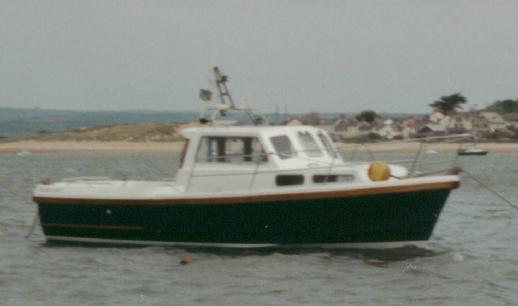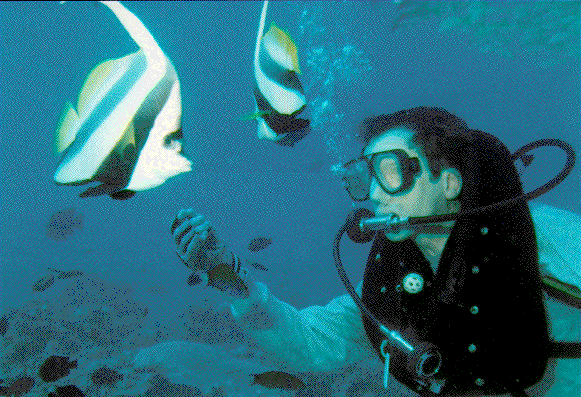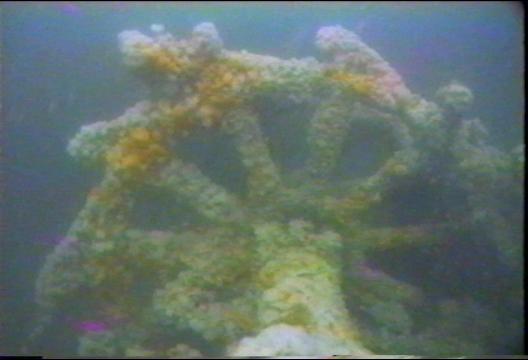

Author of two books of Wrecks of Liverpool Bay and one about the wreck of Lelia. Click for more information.
Transport to the wrecks: MARLIN

For some information on Liverpool Bay diving and MARLIN trips see Marlin Trip
For a brief summary of recent diving from MARLIN see Marlin dives 2009-present and next trip info
One of the wrecks lying in Liverpool Bay:

The wreck of the Lightship ALARM in Liverpool Bay:
To see Introduction to Wreck Detectives TV programme about the
LELIA:
(If not directed to required video: enter "wreck detectives lelia" in
Youtube search box)
My first boat dive
I learnt to dive with the CERN club in Geneva - and they did training dives at Hermance. Hermance was quite a drive from where we lived and I found that the water depth in nearby Creux de Genthod was suitable. With another beginner, Lennart, a Swede working at CERN, and our wives, we hired a rowing boat there. With our wives rowing and two kitted-up divers at the stern we set off. Simultaneously we both rolled back into the lake, leaving our wives to follow our bubbles from the surface. This was my first boat dive.
Don't encourage a barracuda
I joined a dive-boat trip out of Key Largo with Captain Slate -
who was quite a showman: his party piece was to feed a moray, grouper
and barracuda in turn - with a small fish held by its tail in his mouth.
After my buddy and I had watched this, we wandered off around the wreck
and coral reef.
I made the usual "are you OK?" sign (thumb and fingers in a figure
6) to my buddy - he replied with a very nervous OK - with fingers barely
extended. He looked OK and was breathing normally, so I was not overly
worried.
When we surfaced, I asked him about this: he replied that
Captain Slate had advised us to avoid waving fingers - since the
barracuda had poor eyesight and might think they were fish. Moreover, the large
barracuda had followed us round on the dive - being above my head most of
the time. Of course, I had not seen it myself.
Impress a dive guide
As I was walking from our hotel in Hurghada to the nearby diveboat dock - I walked alongside another non-egyptian. I said "hi" and deduced that he was French-speaking. It transpired that he was one of the dive-guides for the boat I was heading for. Moreover, it turned out that, when I was in Geneva, I had trained a diver - who, in turn, had trained him. So I got very good treatment when diving - namely left alone to do my own thing.
The Navy lark
One of my first dives in Liverpool Bay was courtesy of the Liverpool
University Royal Naval Unit which had from 1977-1988 [when replaced by
HMS Charger] an ex Ham-class
minesweeper
HMS Waterwitch (built Cowes 1957, 106 x 22 ft). A work colleague
was associated with the Unit and suggested that since they just went out
of Liverpool Docks for a "jolly" and then returned the same day - it
should be possible to host a pair of amateur divers (myself and a
colleague). This was promising - they had Decca for position finding
and provided a stable platform.
I was asked what we needed - and requested a shotline with
marker buoy which could be deployed on the wreck-site to guide us down.
We duly set off and they cruised back and fore looking for the
charted wreck of the Speke. Their Decca seemed unreliable and the poor
trainee plotting our course on a paper chart was getting frazzled. Then we were
told that they had to stop, head to the waves, while lunch was served.
Eventually, I suggested they just let us dive somewhere close to the
wreck - and offered to jump overboard. This was not permitted and we
had to get into a Gemini (small rubber boat) with two sailors - and the
shot line. This shotline must have been 100 metres long and nearly
filled the boat. My fault, I should have specified 30 metres rather than
leave them to make the decision.
The dive was unremarkable - sand glorious sand. And we were not
invited back.
Inaugurate a fishery
Long ago, I was one of a small group diving the Scottish island of
Coll. On one dive, I spotted a large crayfish [langouste in French, spiny
lobster in America] and
grabbed it and popped it in the boat. We then found a second one. So,
that evening, we asked the manager of the Coll Hotel if he (Alistair
Oliphant) would agree to cook them for us. He said yes, provided he and
his partner could share some of the offering.
This event roused the interest of local fishermen, who had
not known about the crayfish resource, but thereafter attempted to catch
more crayfish (with tangle nets).
The Hillman Minx
I was staying at a hotel on Little Loch Broom and visited a local to
ask for suitable shore dive sites. One was alongside a pier and I duly
set off. There was a lot of varied wreckage on the seabed - including
the remains of a Hillman Minx car. Sheltering in the rear wheel-arch was
a lobster. This was surreal - cars don't shelter lobsters.
After a few moments of awe, instinct returned and the
lobster was bagged and subsequently cooked for us by the hotel.
Do as I say - not as I do
On a Maldivian Island holiday, I joined a dive boat trip which was
going
to dive outside the outer reef - so with a prospect of sharks and
mantas. The Maldivian dive-guide impresssed on us, that, should we see
mantas, we were _not_ to attempt to get a ride by grabbing them.
As the dive progressed, people ran low on air and were
shepherded back to the boat, eventually just leaving the guide and me.
Soon we came across a group of a dozen or two of reef sharks lying on
the bottom, then we spotted 3 mantas wheeling around an outcrop. We
were able to creep up the outcrop, lying on the bottom, just below where
they were turning. And then the dive-guide grabbed hold of one to get a
ride - naughty boy.
When the sun shines
As part of a round-the-world trip, we planned to spend a few days on
the Island of Taveuni in Fiji. I wanted to make sure the dive centre, in
Mattei, had availability - so contacted them. They wanted me to FAX
(this was long ago) my payment details to them - between the hours
of 10pm and 4am UK time. This was tricky - I had to arrange to stay in
the department specially to send the FAX in the evening.
When I got there - I asked why they could only accept a FAX
during that restricted period - the answer was that the FAX was solar-powered and,
since the 180° line passes through Taveuni, they only had sun in our
night.
The dive operation was small with only 6 of us heading out. I was
the least experienced (at 1000 dives). One highlight was the inter-dive
break: we beached on a deserted spot with papaya trees everywhere. The
boatman climbed a tree, and we had fresh fruit on our own tropical
beach.
The Aircraft Carrier
In the early days, when I chartered trawlers to dive Liverpool Bay,
one of the Kingfisher Charts (locations of where fishing boats had
snagged nets) had a wreck site marked "large wreck". I commented to the
skipper that it might prove to be an aircraft carrier.
Some years later I was told of a dive team that had been
looking for the aircraft carrier in Liverpool Bay.
Who needs gauges
Diving a wreck off the coast of Coll, one of the team was a very experienced diver - who dived with just a dive suit, lead belt, fins, cylinder, demand valve and facemask - no depth gauge, contents gauge or watch. I asked him how he managed: his reply was that he knew the depth - because of the nature of the kelp; and he knew the time - because he ran out of air. This is not accepted practice!
Jumping ammunition
The SS Castilian, wrecked on the NW corner of Anglesey, had shells spread everywhere. One of the largest size was brought up - complete with shell in the end of the brass cartridge case. Later, to defuse the ammunition, the shell was removed by knocking it against a rock. Gas had escaped under water - so under pressure - which cause the shell case to jump across the beach when the shell was dislodged. This was not an explosion - and quite gentle - but still a little worrying to some people sitting on the beach. Once the shell had been removed, the shell case could then be rendered completely safe by taking out the cordite and unscrewing the detonator. Soon after this incident, and similar ones, visiting the wreck was prohibited - to avoid any live ammunition being recovered.
Beware fast approaching object
On a trip to the Isle of Man, I arrived in darkness and crept into Derby Haven using my radar to check the channel in. As I approached, an object showed up on the radar approaching me at speed. I could see no navigation lights in that direction. Worrying. Then I heard it - a plane was coming in over the sea to land at Ronaldsway Airport (nearby). My radar had picked it up - and it was, thankfully, not going to collide with me.
Designated Landing Beach
We were diving the south coast of Lundy from 2 inflatables. There was a strong ebb current (to the west) and it was getting to evening time. My buddy and I, on getting to the bottom, found that there was an inshore back-eddy (heading east) which we followed. On surfacing, quite near the anchored boats, those on board were looking down-current (to the west) and did not turn around to see us. Despite shouting and setting my flash-gun to fire regularly, we were not seen, so decided to swim to the nearby shore. The boats spent time looking for us, as they thought, down current. Eventually we were seen, standing on shore, and picked up. This "manoeuvre" attracted the name "designated landing beach" thereafter.
Noisy chopper
On an overnight dive trip to Conwy, on the way out, we dived the
wreck of the Nydia. After their dive, two divers from my boat surfaced
and got aboard - one of them (B) reporting symptoms of a bend - although
the other (N) was free of symptoms. Giving pure oxygen to B did not
seem to alleviate his symptoms, so I called the coastguard. I was quite
near Conwy and offered to land the casualty there - but was told that a
helicopter evacuation would be more effective. At that time, RAF Valley
provided the search and rescue service [SAR 22, later piloted by Prince
William]. They quickly appeared and instructed me by VHF to head at
50° to the wind at a steady speed. The noise with a helicopter
overhead was so great that I had to enter the wheelhouse and shut the
door to be able to hear the VHF. It was surreal to see the winchman
apparently walking on water as he was brought up to the stern of the
boat to land. He hooked on the casualty and whisked him up.
Unexpectedly to us, he then asked the casualty's buddy diver to come in
the helicopter too - to provide additional evidence if needed. The
buddy diver (N) had literally seconds to prepare to be evacuated.
B was put in the decompression chamber at Thingwall and fully
recovered. N was told she was free to leave - but had no money on her.
She eventually got home, and rejoined me with another diver on the next
day at Conwy.
For a brief account of a rather special dive trip in MARLIN (to St. Kilda) see Marlin St Kilda Trip
Manta rays in the Maldives:
mantas movie clip
More on Chris Michael's diving sites and wrecks dived:
Summary of dive locations
Summary of wrecks dived
For some wreck info on Liverpool Bay (mostly based on the above books) see Ukdiving
For comprehensive wreck information (from the UK Hydrographic Office) see wrecksite.eu . This site only gives accurate positions if you subscribe.
For excellent dive guides to North Wales (Barmouth to Great Orme) see here by Chris Holden. [Barmouth to Porth Dinllaen and Port Dinllaen to South Stack are now issued in revised versions as a 2 volume e-book: highly recommended].